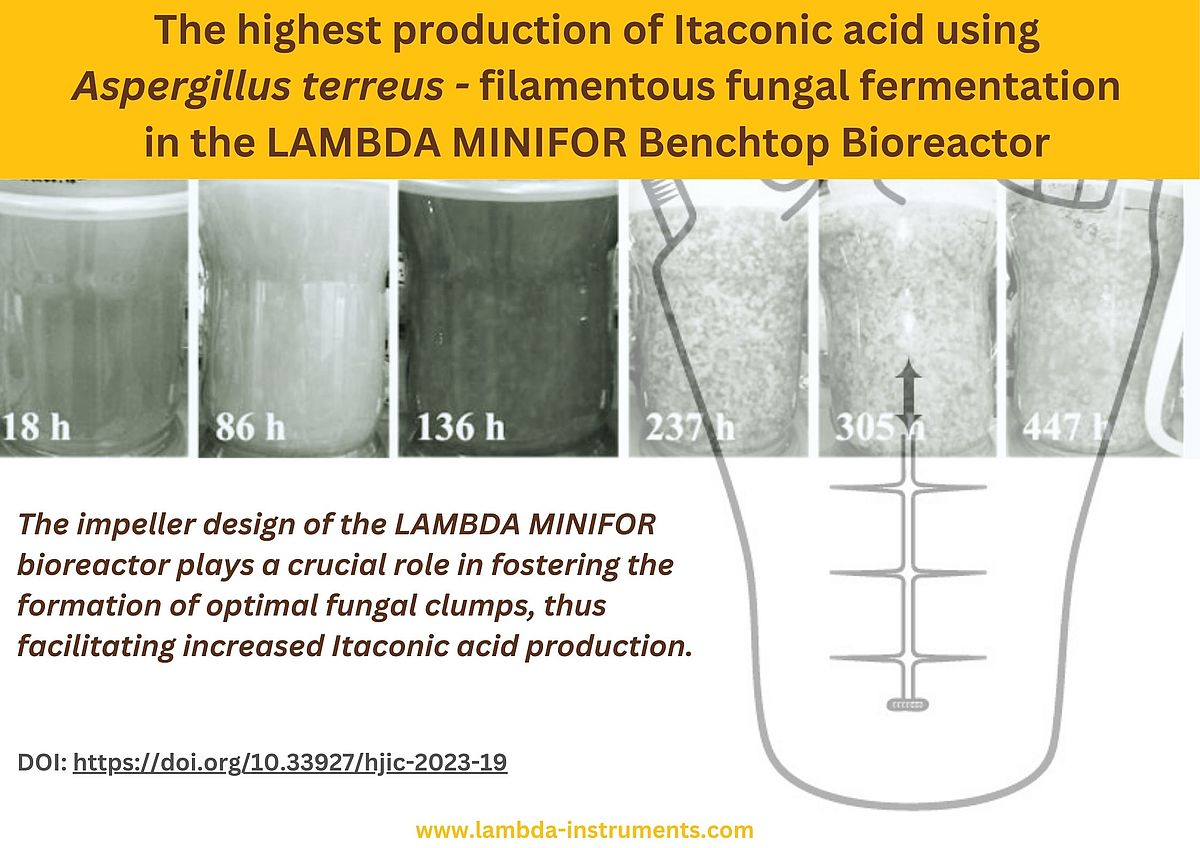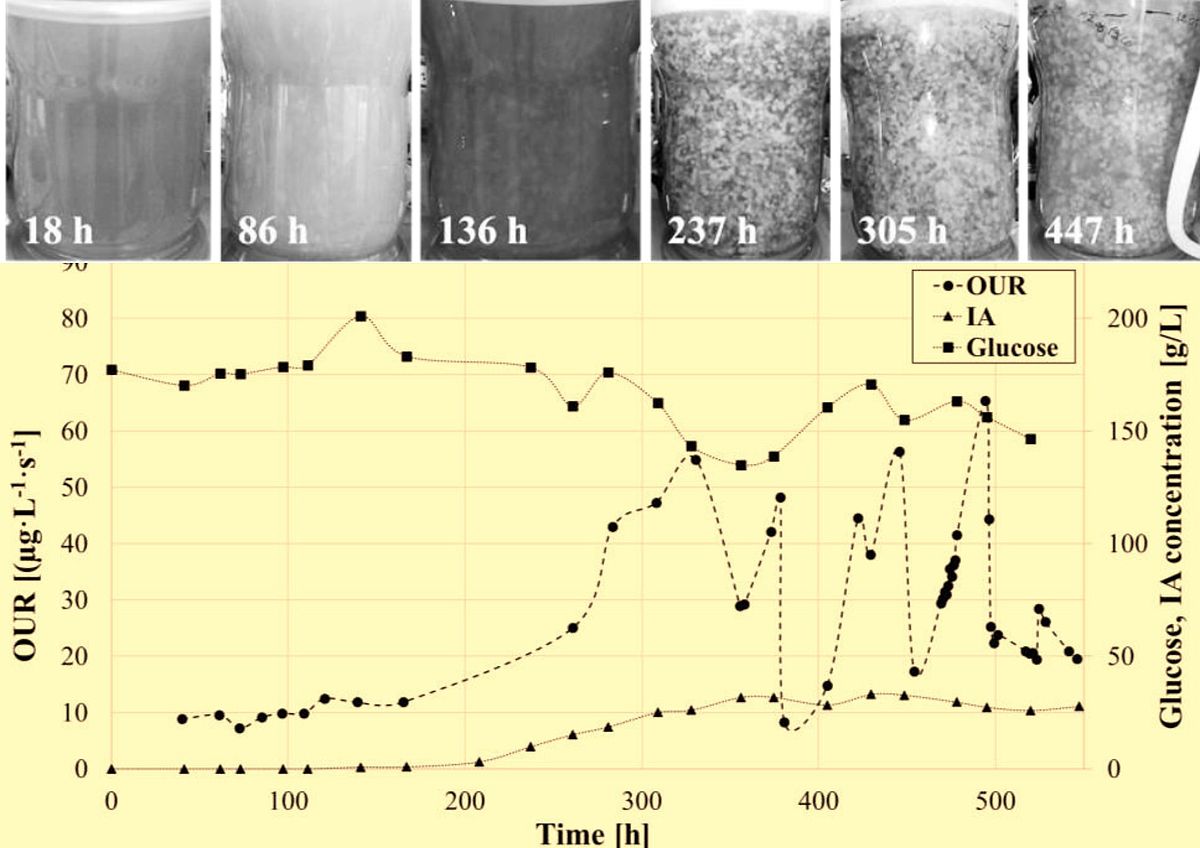Maximized Itaconic Acid Yield: Integrating LAMBDA MINIFOR Bioreactor with Bipolar Membrane Electrodialysis for Highest Productivity
Maximized Itaconic Acid Yield: Integrating LAMBDA MINIFOR Bioreactor with Bipolar Membrane Electrodialysis for Highest Productivity
Aspergillus species are prime examples of filamentous fungi known for their unique morphology, characterized by long, thread-like cells called hyphae. These hyphae interweave to form a network known as mycelium, which plays a critical role in enabling these fungi to thrive in various environments and produce valuable fermentation products, such as itaconic acid (IA).
Itaconic acid has become crucial in several industrial applications, including serving as a cross-linking agent in synthetic latex production and as a monomer for unsaturated polyester resins. Although producing IA via fermentation of Aspergillus terreus is economical, the process generates large amounts of biomass and water waste. To address this, researchers are exploring methods to increase IA production while minimizing waste.
Researchers from the Research Group on Bioengineering, Membrane Technology, and Energetics at the University of Pannonia, Hungary, aimed to enhance IA production through continuous fermentation using the LAMBDA MINIFOR Benchtop Bioreactor. The effluent from the fermentation broth, containing IA, was purified using bipolar membrane electrodialysis (EDBM). The diluate from EDBM was reintroduced into the bioreactor, and the continuous fermentation process lasted for 547 hours.
Continuous fermentation was conducted in a LAMBDA MINIFOR bioreactor with an effective volume of 1.8 L at an operating temperature of 37°C. The necessary dissolved oxygen level was achieved by introducing pure oxygen gas at 0.2 VVM.
Fig 1: The LAMBDA MINIFOR Fermenter’s agitation mechanism provides optimal Aspergillus terreus clumps for Itaconic acid production.
The LAMBDA MINIFOR Fermenter-Bioreactor played a crucial role in enhancing Itaconic Acid production. For increased production of IA, the morphology of Aspergillus terreus proved to be highly significant during fermentation. Researchers noted that clumps or loose pellets of mycelia ranging between 0.4-0.5 mm in diameter were optimal for acid production. The team also confirmed that the novel agitation mechanism of the LAMBDA MINIFOR Bioreactor provided effective mixing while maintaining the required mycelia morphology without compromising the perfect mycelial formation.
Reference: Hülber-Beyer, Éva, Nemestóthy, N., & Bélafi-Bakó, K. (2024). Case Study of Continuous Itaconic Acid Fermentation by Aspergillus terreus in a Bench-Scale Bioreactor. Hungarian Journal of Industry and Chemistry, 51(2), 57–63. doi.org/10.33927/hjic-2023-19
LAMBDA MINIFOR Fermenter-Bioreactor for Filamentous Fungal Fermentation
The LAMBDA MINIFOR Fermenter-Bioreactor played a crucial role in enhancing IA production. The morphology of Aspergillus terreus proved to be significant during fermentation. Researchers observed that clumps or loose pellets of mycelia, ranging between 0.4-0.5 mm in diameter, were optimal for acid production. Additionally, the novel biomimicking fishtail up-down agitation mechanism of the LAMBDA MINIFOR Bioreactor ensured effective mixing while maintaining the desired mycelial morphology without disrupting fungal growth.

Fig 2: Illustration of morphology of Aspergillus terreus and graphical overview of Oxygen uptake rate (OUR), Concentration of glucose and itaconic acid in the fermenter. Reference: Hülber-Beyer, Éva, Nemestóthy, N., & Bélafi-Bakó, K. (2024). Case Study of Continuous Itaconic Acid Fermentation by Aspergillus terreus in a Bench-Scale Bioreactor. Hungarian Journal of Industry and Chemistry, 51(2), 57–63. doi.org/10.33927/hjic-2023-19
Fermentation Process and Results
At the 96th hour, continuous operation of the fermenter commenced and continued for 23 days (547 hours). Effluent was drained through a harvest cannula extending to the bottom of the reactor vessel. The height-adjustable cannulas of the LAMBDA MINIFOR Bioreactor facilitated medium refilling by maintaining a distance of over 5 cm from the surface of the culture. The dilution rate was kept at 0.007 h-1.
The combination of the LAMBDA MINIFOR bioreactor and EDBM technique led to significant results. During the 16-day IA production period, a maximum product titer of 35 g·L⁻¹ was achieved, surpassing previously documented continuous fermentations.
The bioreactor maintained optimal conditions for Aspergillus terreus growth, with controlled oxygenation and agitation facilitating the formation of fungal clumps, which were essential for high IA yields. The EDBM process efficiently recovered IA from the fermentation broth and allowed the reuse of the diluate, reducing waste and enabling continuous fermentation. The increase in production resulted from both the optimized bioreactor conditions and the integration of EDBM for product recovery and process sustainability.
Applications of LAMBDA MINIFOR Fermenter-Bioreactor for Filamentous Fungi
The LAMBDA MINIFOR Fermenter-Bioreactor is ideal for a wide range of research applications involving filamentous fungi, including:
- Enzyme Production: Utilized in the food, feed, and biofuel industries for the production of cellulases, proteases, and amylases.
- Organic Acid Biosynthesis: Crucial for synthesizing citric acid, itaconic acid, and other organic acids for industrial applications.
- Production of Secondary Metabolites: Employed in the biosynthesis of important metabolites like antibiotics (e.g., penicillin, lovastatin).
- Bioremediation: Filamentous fungi can degrade toxic compounds, playing a role in environmental cleanup efforts.
For more details regarding the LAMBDA MINIFOR fermenter-bioreactor, please visit www.fermentador-bioreactor.com/features/ and explore the innovations of the LAMBDA MINIFOR fermenter-bioreactor at www.lambda-instruments.com/fermenter-bioreactor/innovations-of-minifor-fermentor-bioreactor/
If you have any inquiries, require a quotation, or need pricing information for our fermenter-bioreactor system, feel free to reach out to us athttps://www.lambda-instruments.com/contact-us/